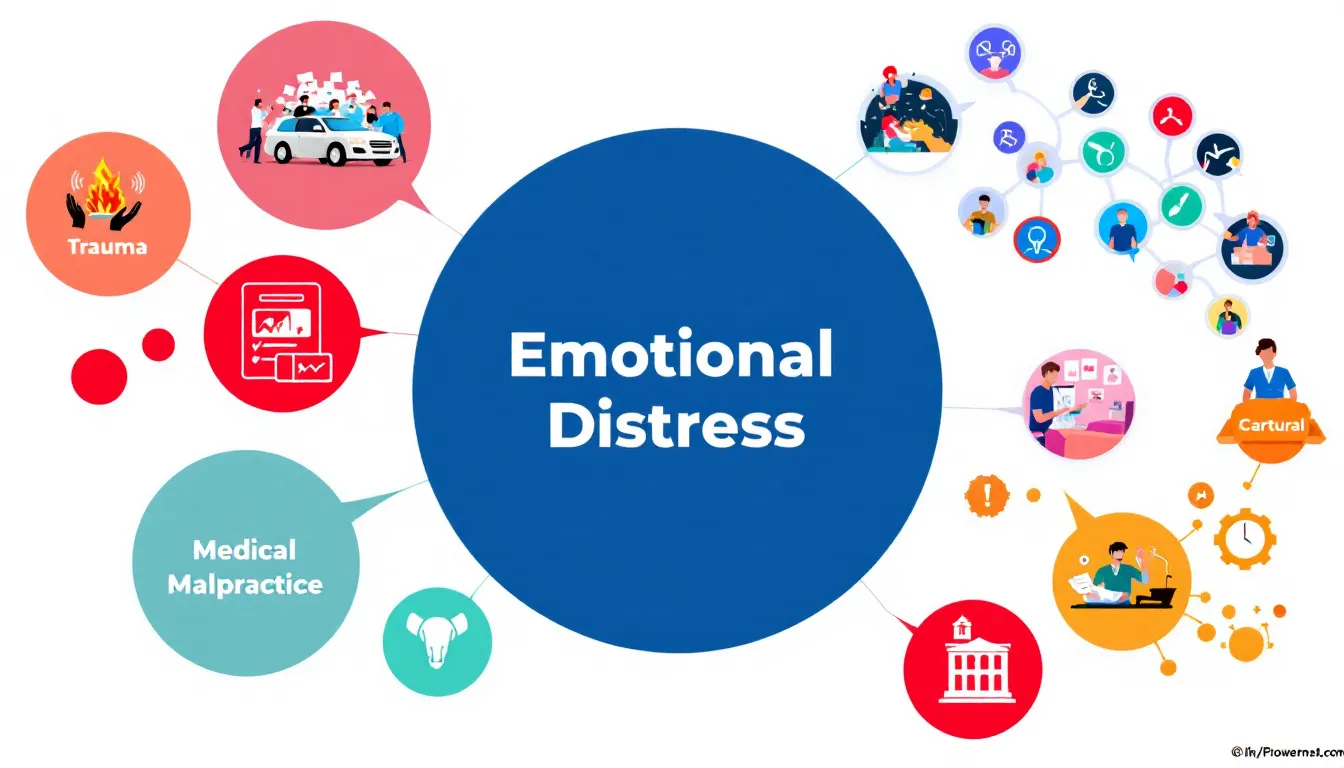Top Emotional Distress Settlement Amounts Explained Simply
Wondering how much you might get for an emotional distress settlement? Emotional distress settlement amounts vary based on the case specifics. This article covers the key factors and potential compensation that you can expect.
Key Takeaways
- Emotional distress claims address psychological injuries, categorized into Intentional Infliction of Emotional Distress (IIED) and Negligent Infliction of Emotional Distress (NIED), requiring detailed personal narratives to support claims.
- Settlement amounts for emotional distress vary widely and are influenced by factors like the severity of the injury, case circumstances, and attorney skill, with compensation ranging from thousands to even millions of dollars, in some cases.
- Effective documentation, seeking professional help, and hiring an experienced personal injury attorney are essential strategies for maximizing compensation in emotional distress claims.
Understanding Emotional Distress Claims
Compensation for psychological harm resulting from negligent or intentional actions is accessible through emotional distress claims, which are a pivotal element in personal injury cases. Such claims aim to compensate victims not only for tangible financial losses like medical bills but also for the intangible anguish they endure, including pain and mental suffering. Emotional distress is considered a form of non-economic damage, which cannot easily be quantified through typical financial metrics like medical bills or lost wages. The challenge with these types of non-economic damages lies in their subjective nature and difficulty to measure, complicating the pursuit of just compensation.
Two primary forms exist under emotional distress claims: Intentional Infliction of Emotional Distress (IIED) and Negligent Infliction of Emotional Distress (NIED). Each type addresses unique aspects of inflicted emotional harm yet converges on the necessity for a compelling personal narrative that sheds light on its impact on an individual’s everyday life. The effectiveness by which plaintiffs convey their stories about their ordeal often plays a crucial role in how others perceive the extent of their emotional duress.
Intentional Infliction of Emotional Distress (IIED)
The concept of intentional infliction of emotional distress (IIED) is grounded in actions taken purposefully to cause severe psychological pain. It concerns behavior that is knowingly injurious and leads to significant emotional trauma. In bringing forth an IIED claim, one must establish the perpetrator’s specific intent to induce such stress. Claims for IIED necessitate evidence showcasing the defendant’s extreme and outrageous conduct, which crosses the line of societal norms by a considerable margin — for instance, enduring persistent unease after a deliberate close call from a vehicle driven by someone who bears you ill will.
To pursue claims related to IIED successfully, it is imperative to present proof that the offender engaged in intentional or recklessly excessive misconduct resulting in profound emotional harm. These allegations are notably complex due to their stringent standard for substantiation. Gathering robust and convincing evidence becomes paramount when advocating such cases.
Negligent Infliction of Emotional Distress (NIED)
Negligent infliction of emotional distress (NIED) occurs when an individual’s careless actions result in another person experiencing emotional pain, regardless of whether there was an intention to cause harm. For a plaintiff to successfully secure damages for NIED, they must establish that the defendant failed to adhere to a recognized standard of care and that this failure resulted in causing the plaintiff’s emotional damage. This type of legal claim is common in instances where it’s predictable that someone’s negligence would lead to mental anguish.
A wide array of incidents can give rise to claims involving NIED. These range from being a direct witness to something horrifying or being part of an incident where significant emotional distress emerges despite no physical injuries manifesting. While establishing NIED may appear less demanding than proving intentional infliction of emotional distress (IIED), substantiating such claims still necessitates conclusive proof showing both the negligent breach by the defendant and its connection with subsequent psychological trauma inflicted on the victim.
How Much Are Emotional Distress Settlement Amounts Worth?
The process of evaluating compensation for emotional distress is inherently subjective and can differ greatly depending on the unique details of each case. The intensity and persistence of emotional distress play a crucial role in influencing potential settlement figures. When calculating compensation for such injuries, considerations include both the depth of physical and emotional suffering as well as related medical expenses. The significance of physical and emotional pain and suffering in personal injury cases cannot be overstated, as it impacts victims beyond just medical expenses. In certain instances, claims may be primarily composed of emotional injuries which then heavily influence the total amount agreed upon in settlements.
In terms of financial restitution for these types of damages, settlements might be anywhere from several thousand dollars to even millions of dollars based on case specifics. There are varied methodologies utilized when assigning a monetary value to cases involving emotional pain within personal injury lawsuits. These techniques factor in various elements that shape the conclusive settlement amount, including how clear-cut liability is within a claim and what losses have been sustained as part of this calculation process.
Factors Influencing Settlement Amounts
The settlement amounts for emotional distress are greatly affected by the extent of the suffering experienced, how reasonable the circumstances were that caused such distress, and effectively communicating these details to a jury. Factors like assurance regarding liability, the damages being pursued, and the defendant’s willingness to engage in discussions also play crucial roles in determining settlements for personal injury cases that involve claims of emotional distress.
Critical elements impacting final settlement figures include injury severity level as sustained by an individual involved in personal injury litigation, particular details unique to each case, and legal representation proficiency. Plus back-and-forth negotiations. The likelihood of a court deeming responsibility lies with one party over another coupled with precise quantification of asserted damages can aid in arriving at what would be considered an equitable offer during settlement deliberations.
Examples of Emotional Distress Settlements
Settlement amounts for emotional distress can vary greatly. In the personal injury context, settlements cover a wide spectrum, ranging from small sums all the way up to the multimillion-dollar bracket. Cases involving substantial emotional injury often pertain to serious incidents such as sexual abuse or profound trauma.
Clients contending with these types of situations might incur medical expenses reaching up to hundreds of thousands of dollars due to their emotional injuries. Data derived from entities like Jury Verdict Research demonstrate that median settlement values are approximately twelve times lower than average awards in this context. This discrepancy suggests that a few particularly large verdicts tend to raise the average award significantly above what is typical—the median value.
Methods to Calculate Emotional Distress Damages
Calculating damages for emotional distress lacks a uniform approach, with the process differing from one case to another. Three principal techniques—the Multiplier Method, Per Diem Method, and Financial Impact Method—are utilized in these calculations, each tailored to accommodate the distinct nature of individual cases.
Under the Multiplier Method, a multiplier reflecting emotional distress severity is applied to economic damages. Conversely, using the Per Diem method involves determining an everyday value for suffering due to emotional distress and multiplying this by how long it lasts. Lastly, through the Financial Impact Method, estimations are based on actual expenses incurred like lost wages and costs associated with therapy sessions.
The Multiplier Method
The multiplier method is commonly used and involves applying a factor that reflects the severity of emotional distress to economic damages. This factor typically ranges from 1.5 to 5, depending on the intensity of the distress.
For example, if the total economic damages amount to $10,000 and the multiplier is 3, the emotional distress damages would be $30,000.
The Per Diem Method
The per diem approach assigns a fixed daily rate to reflect the extent of emotional suffering and calculates compensation for emotional distress accordingly. By determining this daily figure, one can then multiply it by the number of days over which the individual experienced distress, offering a formulaic method for evaluating potential damages in claims related to such distress.
For instance, utilizing the per diem technique involves multiplying an established daily amount indicative of the anguish by each day that pain was endured. Should someone have been given $100 as their daily measure and faced 200 days under emotional strain, they would be entitled to receive $20,000 in compensation for their emotional turmoil.
The Financial Impact Method
The Financial Impact Method determines the amount of compensation for emotional distress by accounting for the concrete expenses that have been accrued. These can encompass charges from therapy sessions, psychiatrist meetings, prescriptions required to manage one’s mental health, as well as any earnings that were not received due to the trauma experienced.
By focusing on tangible financial setbacks incurred by the individual affected, this approach provides a solid framework for estimating emotional distress compensation. To illustrate, should expenses related to therapy equal $5,000, and forgone income due to incapacitation stand at $15,000? Then, under this method, restitution for emotional distress would sum up to $20,000.
Legal Requirements for Proving Emotional Distress
In court, emotional distress is considered to be severe when it escalates to a level that would be intolerable for any reasonable person, leading to significant mental suffering. Severe emotional distress is a serious condition that can arise from situations caused by others’ actions.
To establish entitlement to remuneration for emotional distress in legal proceedings, claimants must convince the judge or jury of their case.
Several factors contribute to determining the intensity of emotional distress.
- The strength
- How long it lasts
- Its origin
- Symptoms indicative of accompanying physical pain
The extent and duration are particularly important in gauging the gravity of the distress experienced. Enduring such stress over an extended period typically suggests a more serious impact.
Substantiating claims of emotional anguish demand comprehensive evidence beyond just what the plaintiff states. This holds especially true with cases involving intentional infliction of such trauma (IIED). Plaintiffs aiming for compensation need not only demonstrate actual or anticipated psychological strain but also confirm they suffered financial losses as well.
Accordingly, most jurisdictions adhere to the Foreseeability Rule, which stipulates no necessity for a concurrent bodily injury. Rather, it is sufficient if one could reasonably anticipate that an individual might sustain some form of psychological harm due to another’s conduct. State laws differ on whether proof requires an associated physical injury when filing claims based on inflicted emotional turmoil.
Medical Records and Documentation
Consistent medical records are essential, as they provide a documented history of the emotional distress and treatment received. Keeping comprehensive records of emotional distress is vital for substantiating claims with insurers or in court. Statements from witnesses, including mental health experts, can substantiate a plaintiff’s claims by reflecting observed changes due to emotional distress.
Mental health professionals provide essential documentation of emotional distress and assist in developing effective coping strategies. Keeping a detailed journal of emotional struggles can provide essential evidence to support claims of emotional distress.
Witness Testimonies
Testimonies from witnesses can greatly strengthen claims of emotional distress by offering an external viewpoint on the plaintiff’s condition. These accounts may originate from a diverse group of individuals such as relatives, acquaintances, or work associates, all contributing layers to the account of emotional trauma.
Expert opinions provided by mental health professionals can elucidate both the severity and scope of the plaintiff’s psychological turmoil and its effect on their daily existence. Corroboration through statements from others who are pertinent to the situation, like colleagues or people who witnessed incidents firsthand, can lend additional support and legitimacy to a claim involving emotional distress.
Plaintiff’s Own Testimony
The firsthand testimony of the plaintiff is paramount, offering a direct portrayal of the emotional distress they have undergone. Such accounts carry substantial weight in legal proceedings as they vividly convey the profound turmoil endured. Plaintiffs often need to convey how they suffered emotional distress due to incidents caused by someone else’s negligence or wrongdoing.
A convincing personal account can greatly enhance prospects for achieving a positive settlement or ruling by influencing how judges or jurors perceive the situation. When articulated well in a courtroom setting, an individual’s recounting of their experiences bolsters the credibility and significance of their claim for emotional distress.
The Role of an Experienced Personal Injury Attorney
Engaging a skilled lawyer can markedly increase your chances of being awarded compensation for emotional distress. By methodically documenting the case and working closely with attorneys, individuals are more likely to receive just compensation for their emotional harm. Lawyers specializing in personal injury cases assist their clients in seeking the highest possible financial redress for their pain and suffering, guiding them through every step of the claims process so that they can concentrate on healing.
An attorney who specializes in injuries offers assistance by gathering proof, negotiating settlement terms, and steering through the legal processes involved in court. It is crucial to consult with an attorney to understand specific local rules and regulations pertinent to claims related to emotional distress.
Collecting Evidence
Lawyers are pivotal in collecting and assembling both personal testimonies and factual proof to support claims of emotional distress. This incorporates acquiring insights from observers or experts that offer crucial substantiation and perspective for the assertion of emotional trauma. Through careful accumulation and systematic arrangement of such evidence, legal counsel enhances the credibility of a client’s claim, thereby bolstering its impact during settlement discussions or judicial trials.
Negotiating Settlements
Having adept negotiation abilities is crucial for lawyers striving to obtain maximum compensation for emotional distress damages. By employing strategic negotiation methods and thoroughly grasping the intricacies of the claims procedure, attorneys can increase the chances of securing enhanced compensation. A seasoned attorney plays a key role in settlement negotiations, making certain that all aspects of emotional distress are compellingly conveyed in legal proceedings.
Securing the services of an informed attorney can markedly boost your prospects of acquiring more substantial compensation by proficiently negotiating and advocating your case. They serve as powerful advocates on behalf of their clients, bargaining with insurance firms or counterparties to achieve an optimal resolution that fairly compensates for the plaintiff’s emotional suffering.
Navigating Court Procedures
Attorneys specializing in personal injury provide essential guidance to clients as they tackle the complicated legal processes associated with emotional distress claims. The complexities of court procedures can be daunting, and professional legal advice is crucial for those pursuing claims of emotional distress.
With an adept attorney at their side, individuals can deftly handle intricate legal obstacles and secure strong advocacy aimed at obtaining optimal compensation. These attorneys make certain that every pertinent detail of a case is meticulously considered, offering clients the highest likelihood of triumphing in their emotional distress claims.
Common Emotional Distress Cases

Claims of emotional distress can originate from a multitude of circumstances, such as accidents which may provoke conditions like anxiety or depression. Frequently, these claims emerge in the wake of vehicular collisions, harassment within the professional environment, and incidents involving wrongful death. Awareness of the typical contexts that precipitate emotional distress claims is beneficial for individuals to discern their potential eligibility for financial recompense.
Multiple events have been known to give rise to claims pertaining to emotional harm. This includes traffic mishaps, occupational altercations, and cases concerning wrongful death. Each scenario has the capacity to inflict considerable psychological damage on an individual, necessitating both legal and therapeutic measures in order to manage its profound effects.
Auto Accidents
Claims of emotional distress are a critical aspect of personal injury lawsuits related to automobile accidents because they encompass the psychological consequences of the accident. To any physical harm incurred. Such incidents frequently result in enduring psychological anguish that impairs the affected individual’s life satisfaction and overall mental health. Notably, auto accidents may give rise to severe emotional reactions such as anxiety and post-traumatic stress disorder (PTSD), which can disrupt everyday activities.
Addressing these significant emotional impacts is essential for those suffering long-term mental health complications following an auto accident, necessitating both legal representation and therapeutic care. To assist victims with their claims for compensation covering both their physical injuries and the accompanying emotional trauma, it is crucial to engage an experienced personal injury attorney who understands the intricacies involved in asserting emotional distress claims within this legal domain.
Workplace Incidents
Incidents in the workplace can cause profound emotional distress, impacting an employee’s mental state and general welfare. Such incidents that could result in legal claims encompass workplace harassment, discrimination, wrongful dismissal, and bullying at work. Harassment often triggers this distress, leading to conditions like anxiety, depression, or post-traumatic stress disorder due to the inflicted experiences.
Likewise, traumatic situations such as accidents or acts of violence within the work environment can inflict enduring emotional harm requiring ongoing support. Legal counsel may assist employees in pursuing compensation for their emotional suffering while also ensuring employers are held responsible for maintaining a secure working atmosphere.
Wrongful Death Cases
Lawsuits involving emotional injury are divided into two primary types: those associated with wrongful death and those that do not involve wrongful death. In the state of Maryland, when dealing with wrongful death cases, there is an imposed limitation on the amount of non-economic damages that can be rewarded. This cap is set at a maximum of one million dollars, constraining the jury’s discretion in determining suitable compensation for any experienced emotional distress.
In evaluating these claims, defense attorneys often view older victims’ emotional injuries as less impactful than those suffered by younger persons, which may affect how cases are appraised in terms of value. Despite such hurdles, family members remain entitled to pursue reparation for their pain and suffering stemming from the tragic and untimely loss due to a loved one’s wrongful death.
Maximizing Your Emotional Distress Compensation
The quality of life, personal relationships, and work capacity can be gravely affected by emotional distress. The depth of the individual’s suffering and their personal stories play a pivotal role in evaluating settlement amounts. Strengthening a claim for settlement is often achieved through thorough documentation of how daily life has been altered due to emotional distress.
To optimize the potential for receiving considerable compensation for emotional injuries, it is essential to compile detailed records, pursue professional assistance, and obtain legal counsel. Following these measures can markedly elevate the likelihood of securing ample recompense for the inflicted emotional harm.
Detailed Documentation
To increase compensation, it is crucial to meticulously record the emotional and psychological consequences experienced by families who suffer from significant emotional distress due to a loved one’s wrongful death. This traumatic event can adversely affect their financial stability as well as their mental health. By amassing substantial proof and clearly illustrating the extent of this anguish, claims are reinforced, which may enhance the chances of securing greater financial reparation.
Seeking Professional Help
Engaging the expertise of mental health professionals is vital for those suffering from emotional distress as they offer essential understanding and avenues for therapy. When these professionals document cases of emotional distress, it bolsters the validity of such claims in a judicial environment. Skilled personal injury lawyers are adept at collecting relevant evidence, engaging with insurers, and managing intricate legal procedures tied to claims involving emotional distress.
Both psychological experts and attorneys play pivotal roles in securing proper care and equitable recompense for individuals afflicted by emotional trauma. Obtaining professional assistance can markedly impact the resolution of claims related to emotional distress.
Contact 1-800-THE-LAW2 today for a free legal consultation with an attorney in our professional network.
Legal Representation
It is essential to engage the services of a personal injury attorney with experience when pursuing claims for emotional distress, as they are instrumental in achieving maximum compensation. These attorneys gather robust evidence, including medical records and accounts from witnesses, which bolster cases involving emotional distress.
Such lawyers possess adept negotiation skills that prove beneficial in obtaining favorable settlements from insurance firms or adversaries. They also provide guidance through intricate legal processes to ensure every critical aspect of the case is considered and handled appropriately.
Summary
In summary, it’s vital to grasp the nuances of emotional distress claims and what affects potential settlement figures when pursuing compensation. To enhance your claim, keep detailed records of your emotional pain, consult with professionals for help, and engage a skilled lawyer. It is important to acknowledge that the emotional suffering you or a loved one have endured warrants both acknowledgment and monetary redress. Ensure you take appropriate action in order to obtain the assistance and compensation that is rightfully yours.
Frequently Asked Questions
What are the types of emotional distress claims?
Claims of emotional distress are typically classified into two main types: Intentional Infliction of Emotional Distress (IIED) and Negligent Infliction of Emotional Distress (NIED).
It is essential to comprehend these differences in order to evaluate the legitimacy of claims involving the infliction of emotional distress.
How is emotional distress compensation calculated?
Emotional distress compensation is typically calculated using methods such as the Multiplier Method, which multiplies economic damages by a certain factor, the Per Diem Method, which assigns a daily value for emotional pain, and the Financial Impact Method, which assesses the overall impact on the individual’s life.
Each method aims to quantify the intangible effects of emotional distress.
What evidence is required to prove emotional distress?
To prove emotional distress, you will need medical records, witness testimony, and your own personal testimony to support your claims effectively. This comprehensive evidence is crucial to establish the severity of your emotional suffering.
Why is it important to hire an experienced personal injury attorney for emotional distress claims?
Securing the services of a personal injury attorney with substantial experience is vital when it comes to claims involving emotional distress. They are adept at gathering necessary evidence, negotiating settlements proficiently, and steering through intricate legal processes, thereby significantly improving your prospects of obtaining compensation.
What factors influence emotional distress settlement amounts?
Emotional distress settlement amounts are influenced by the severity and duration of the distress, the certainty of liability, and the defendant’s willingness to negotiate.
These factors play a crucial role in determining a fair settlement.




